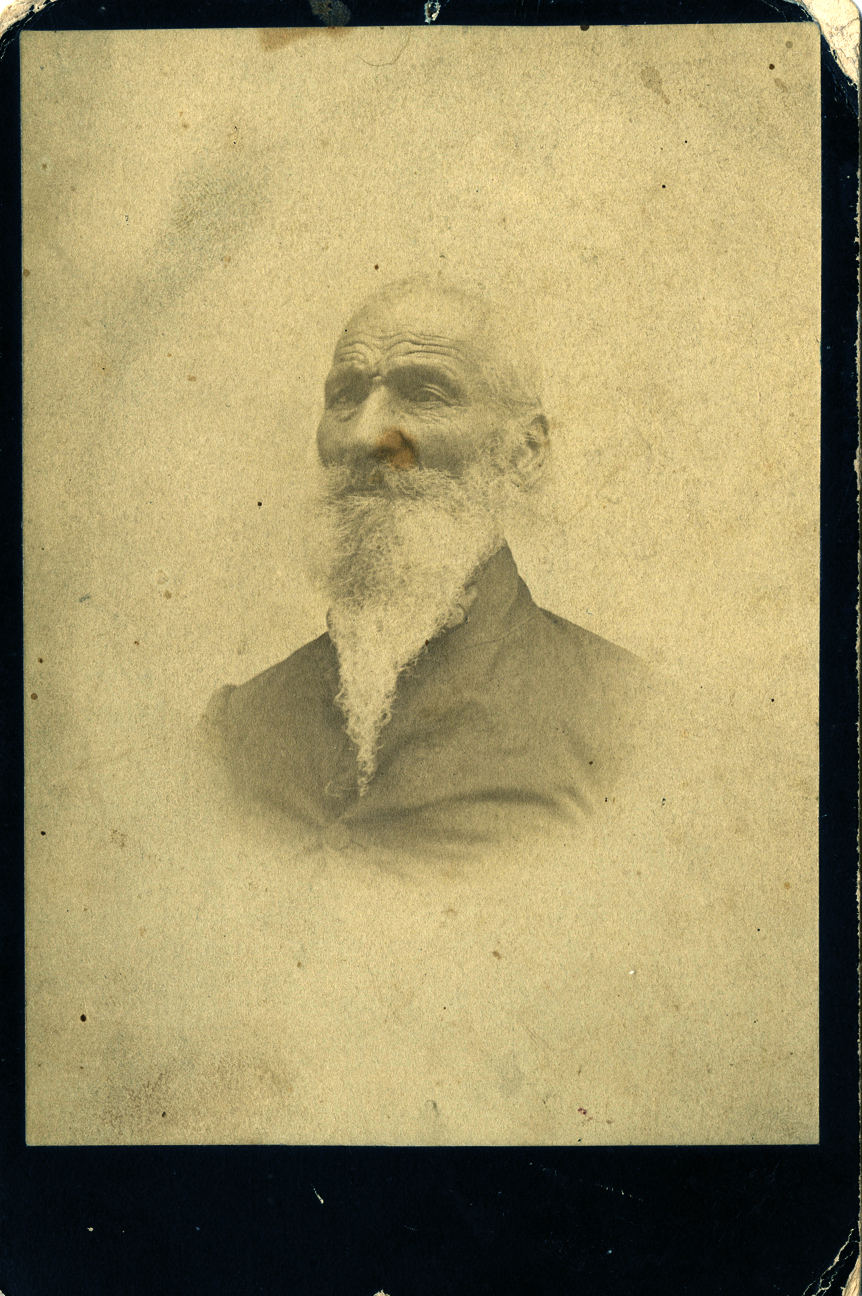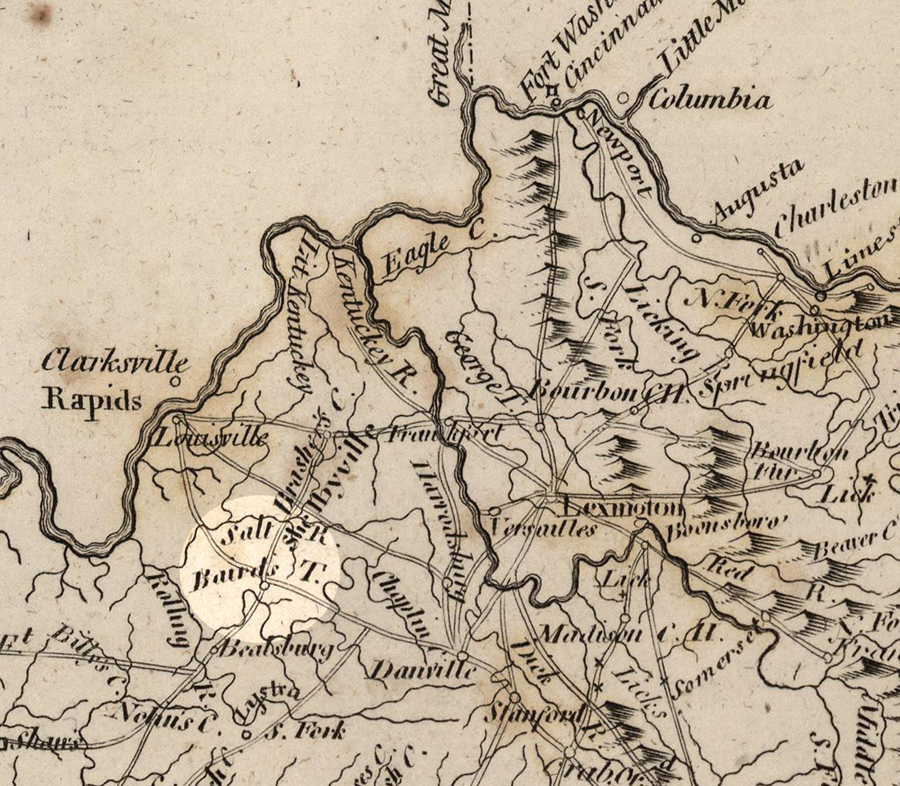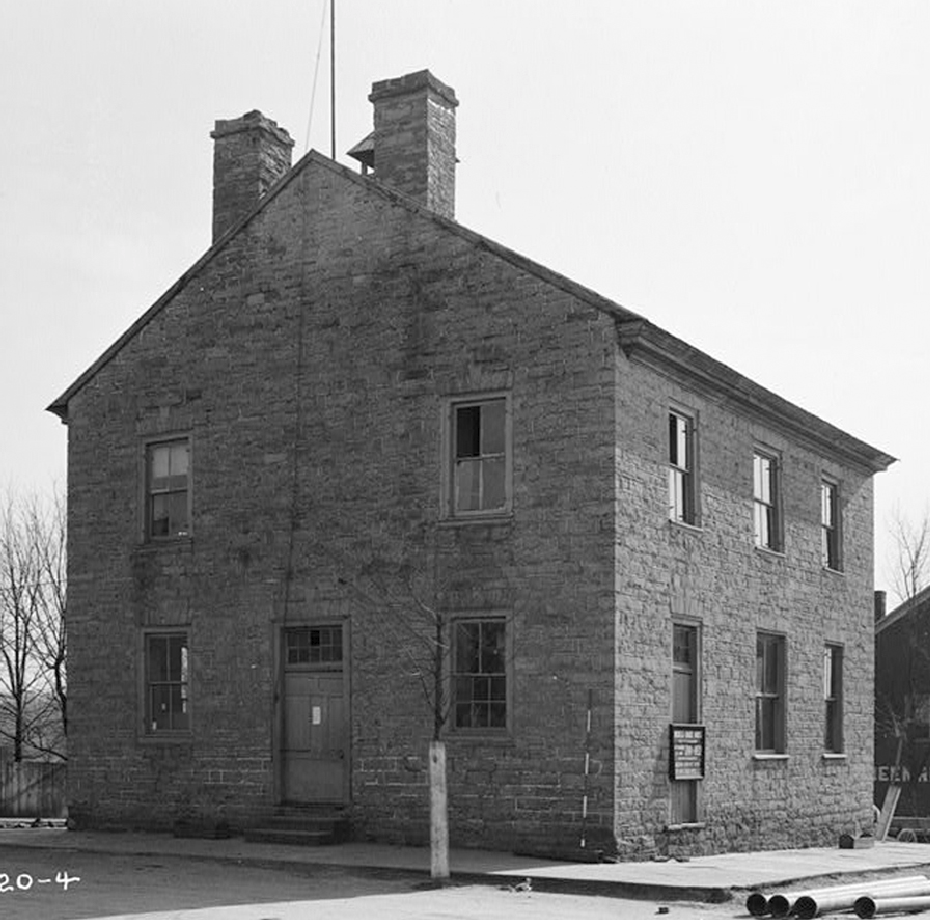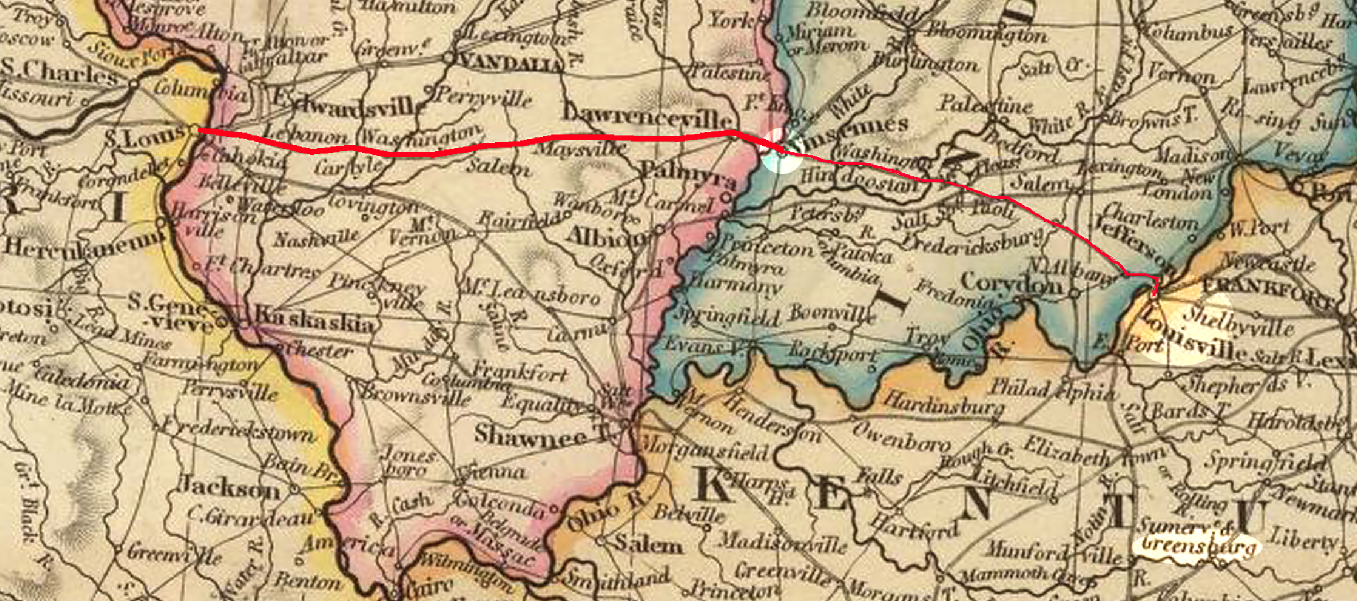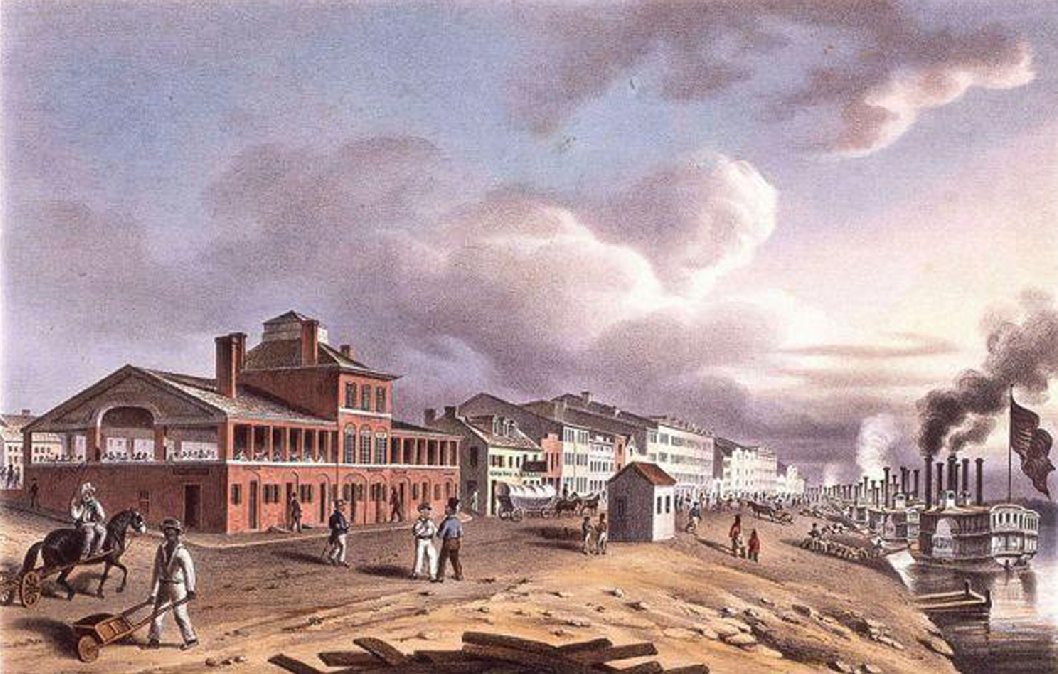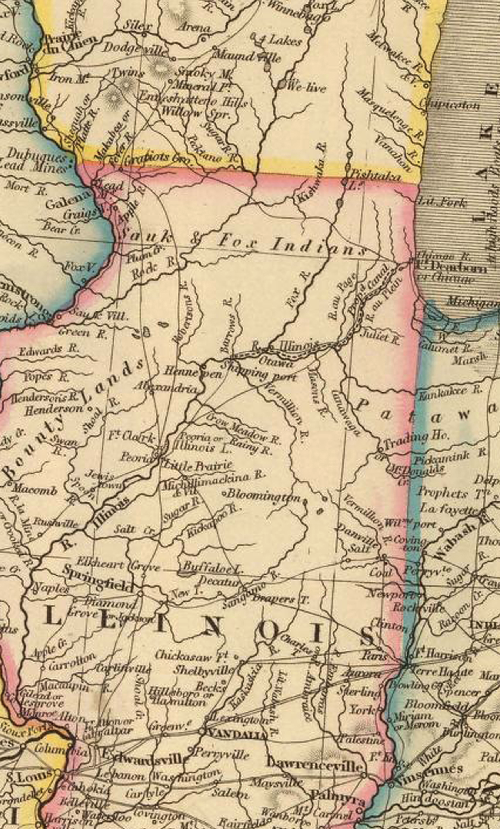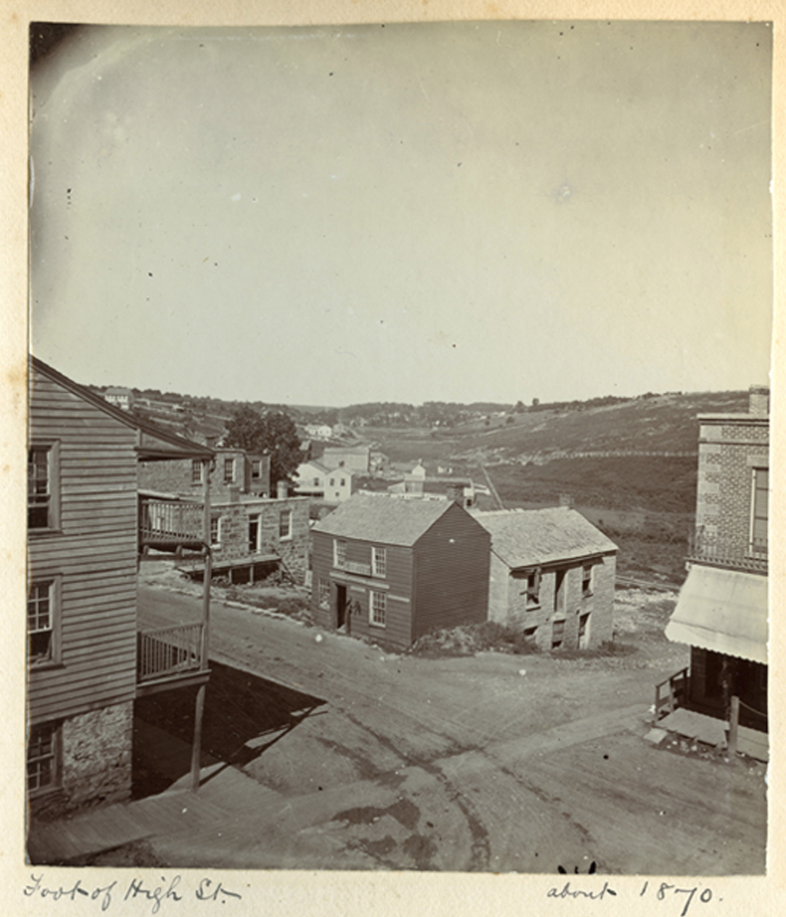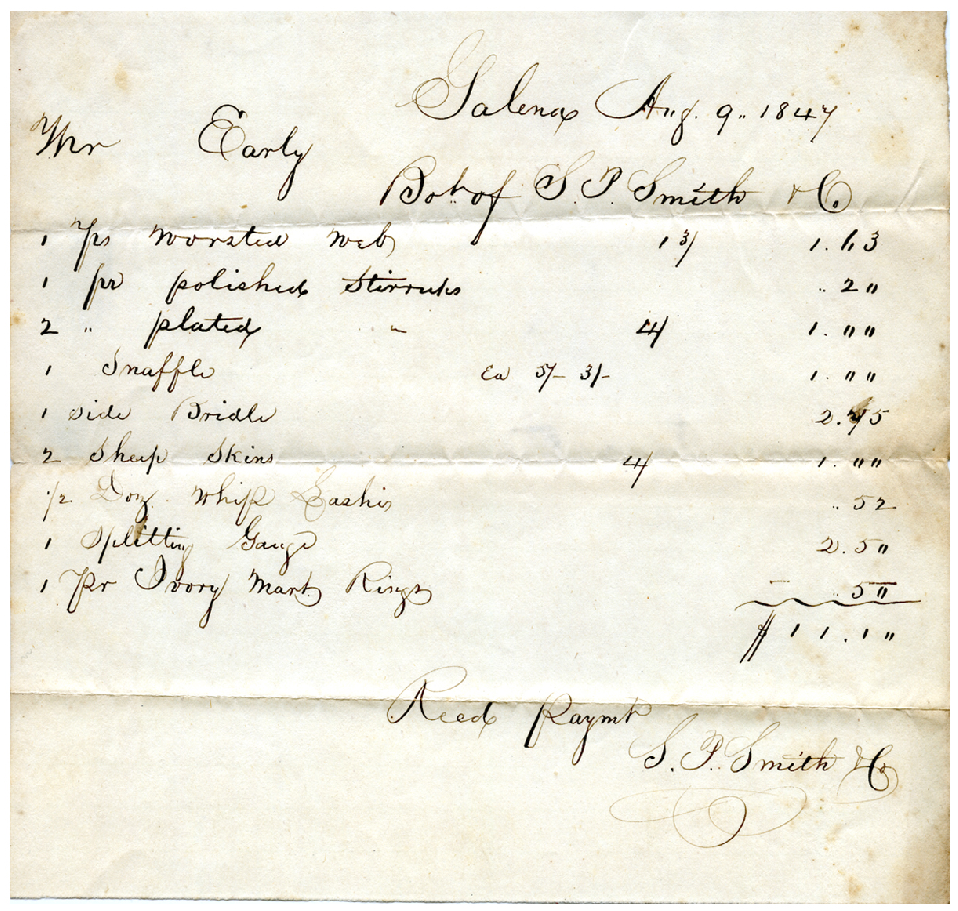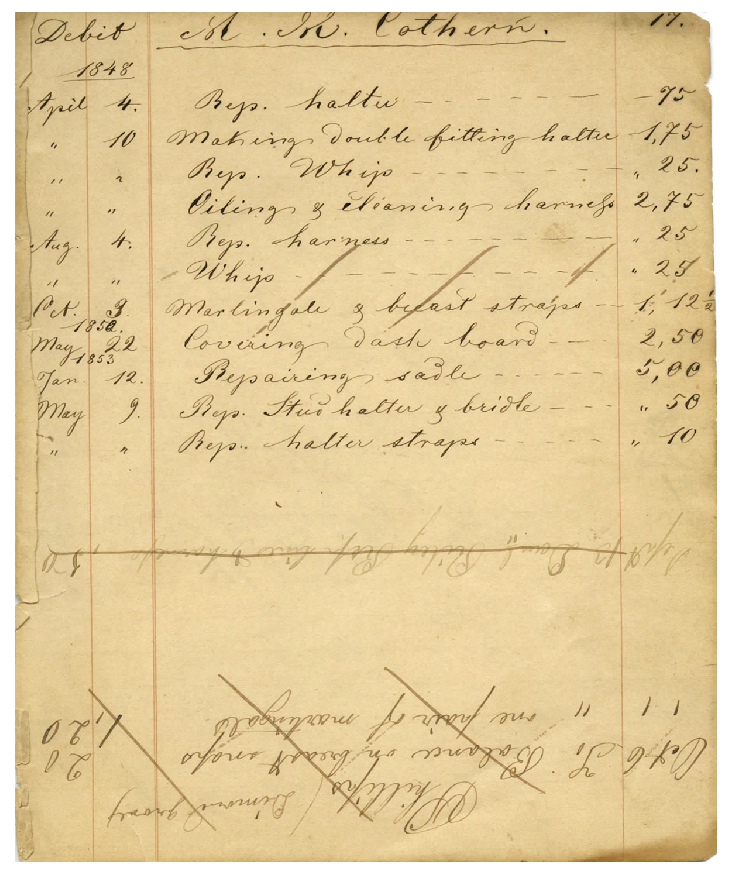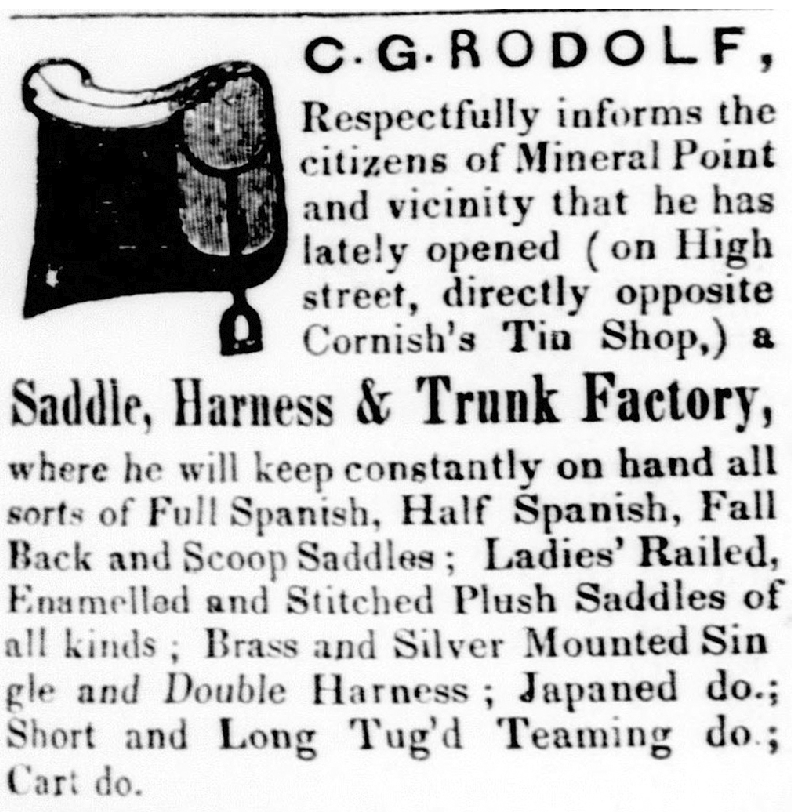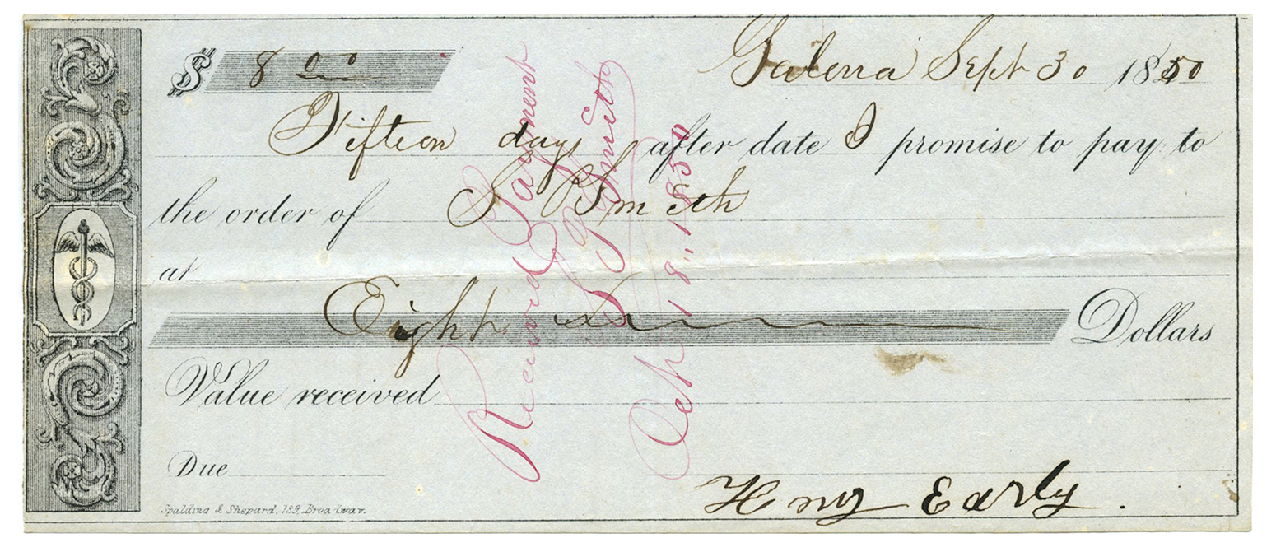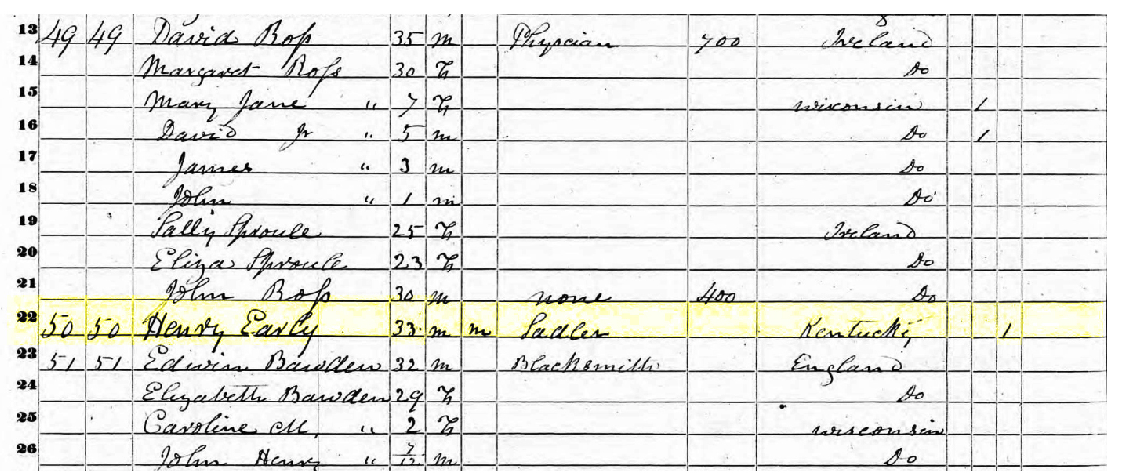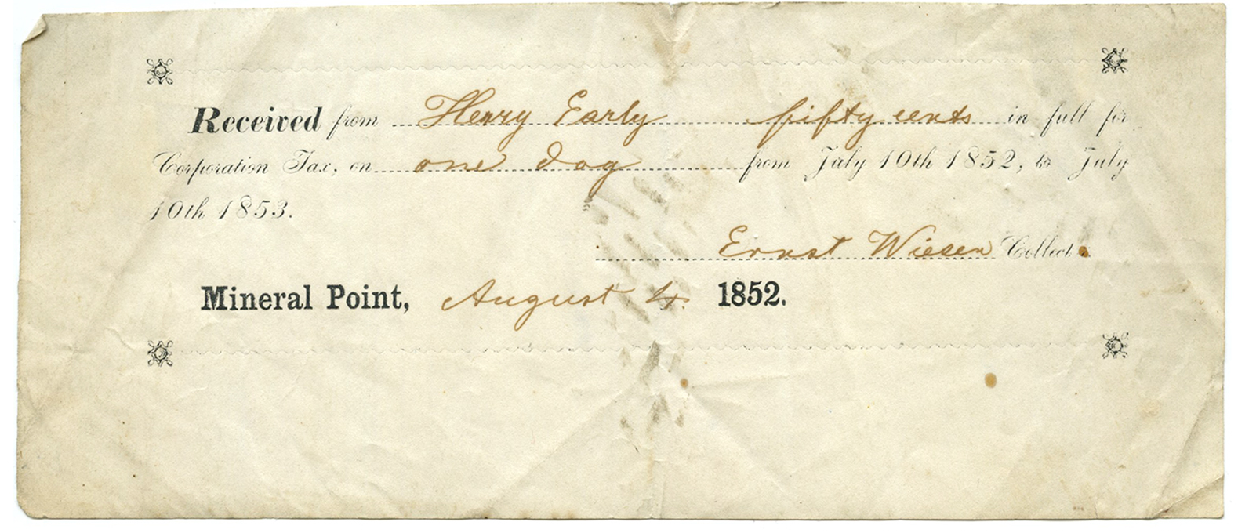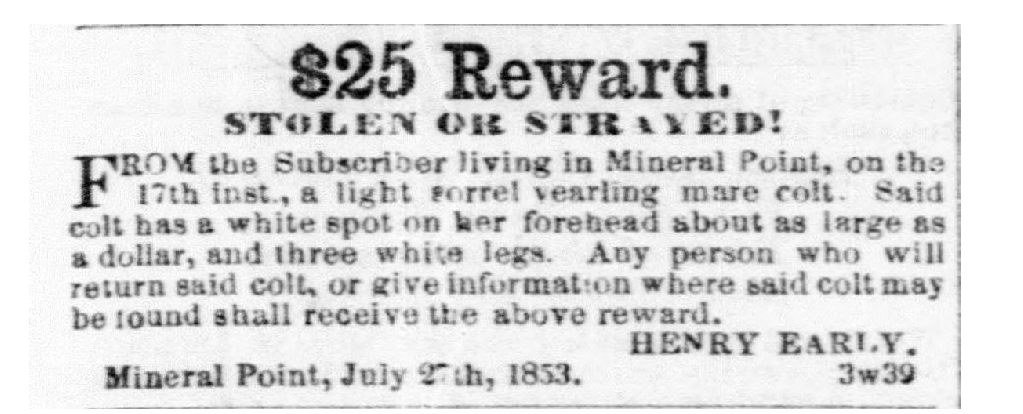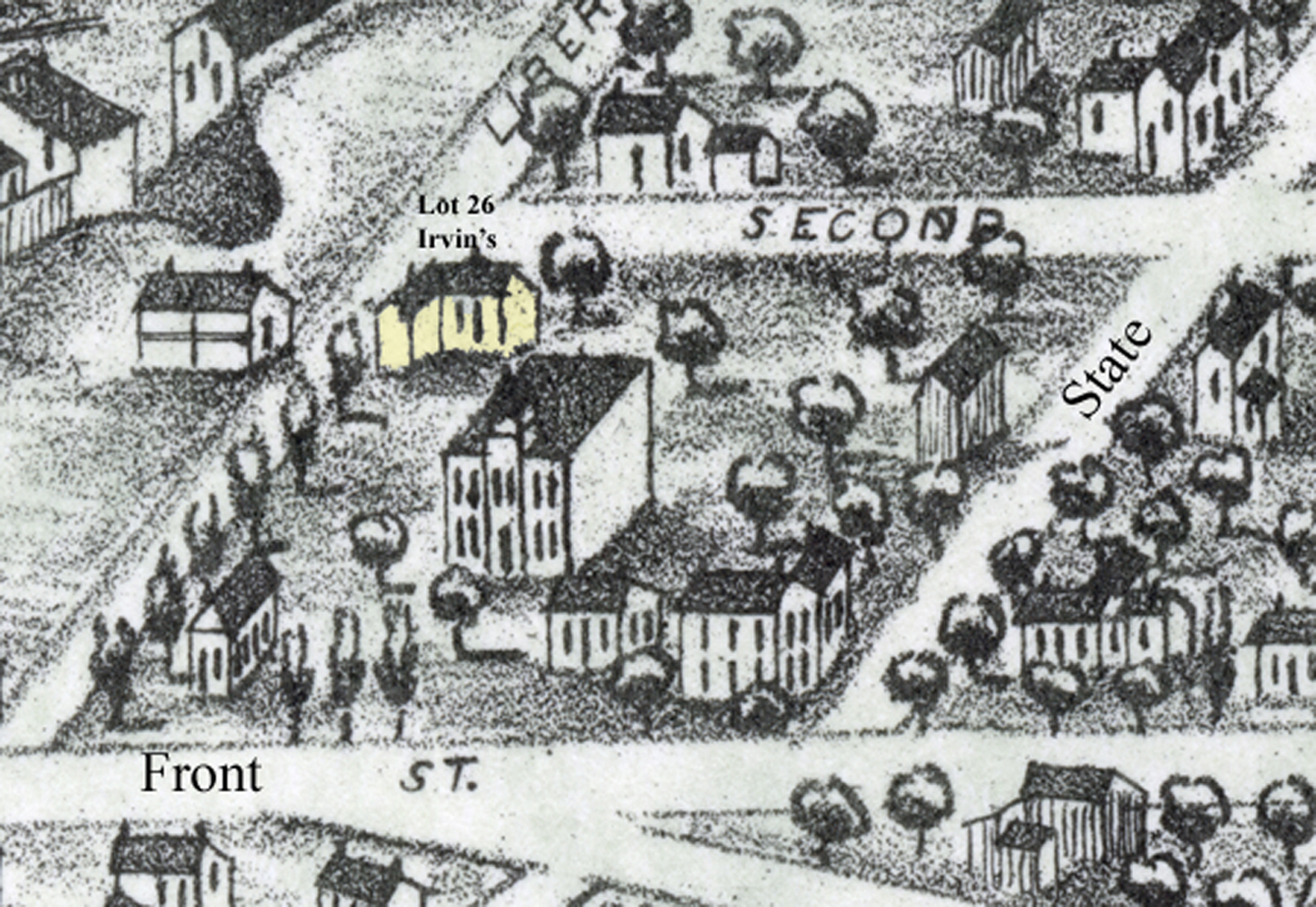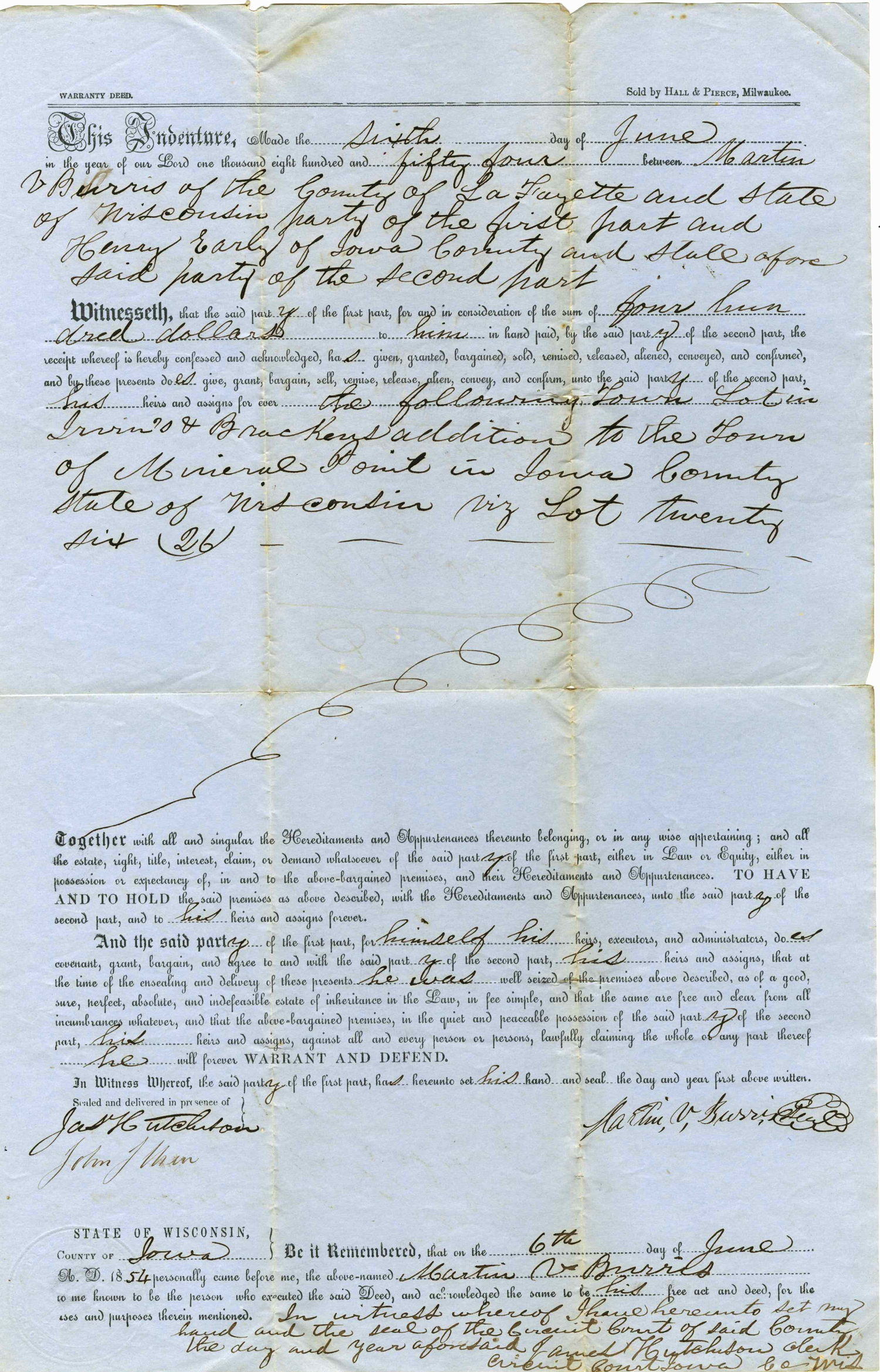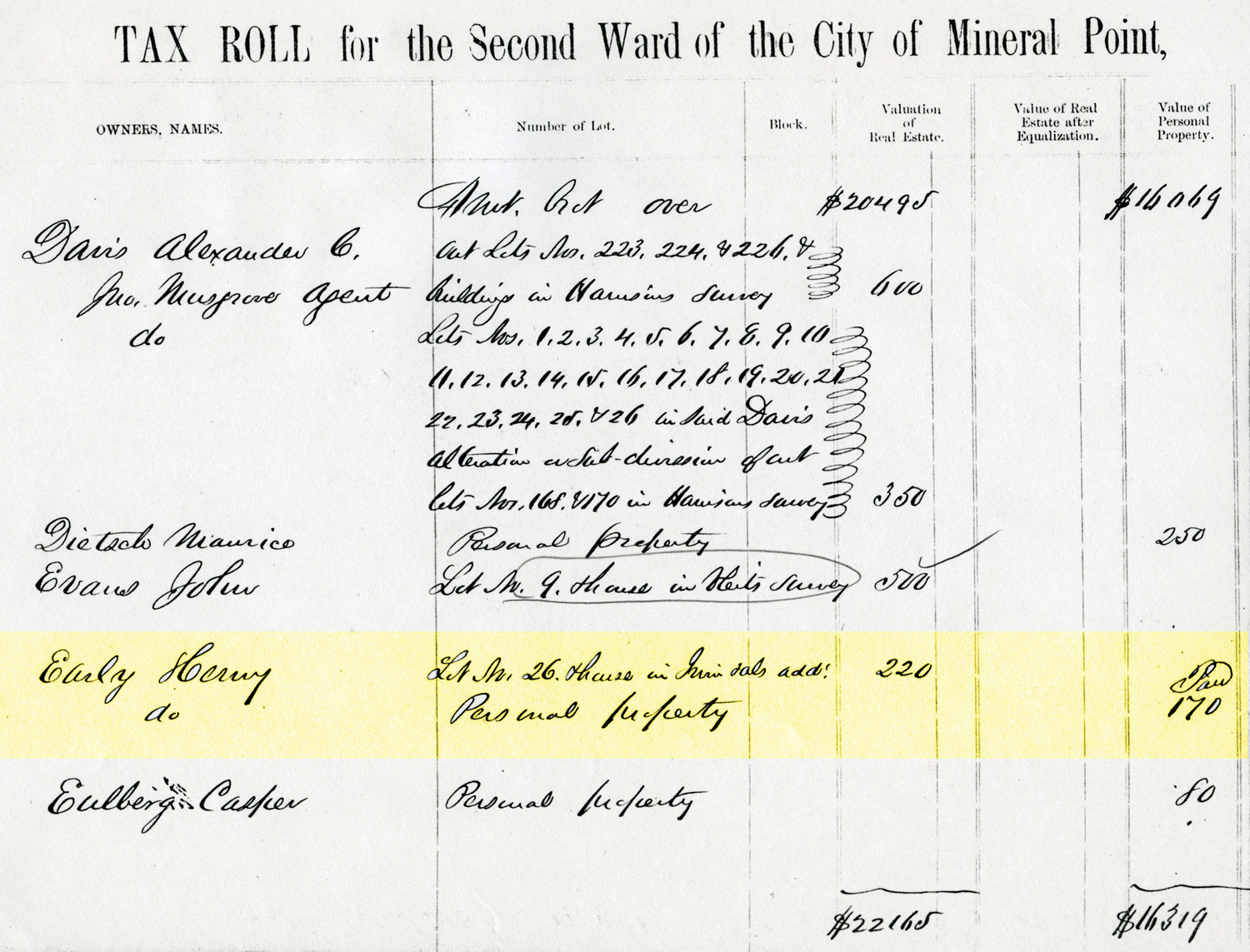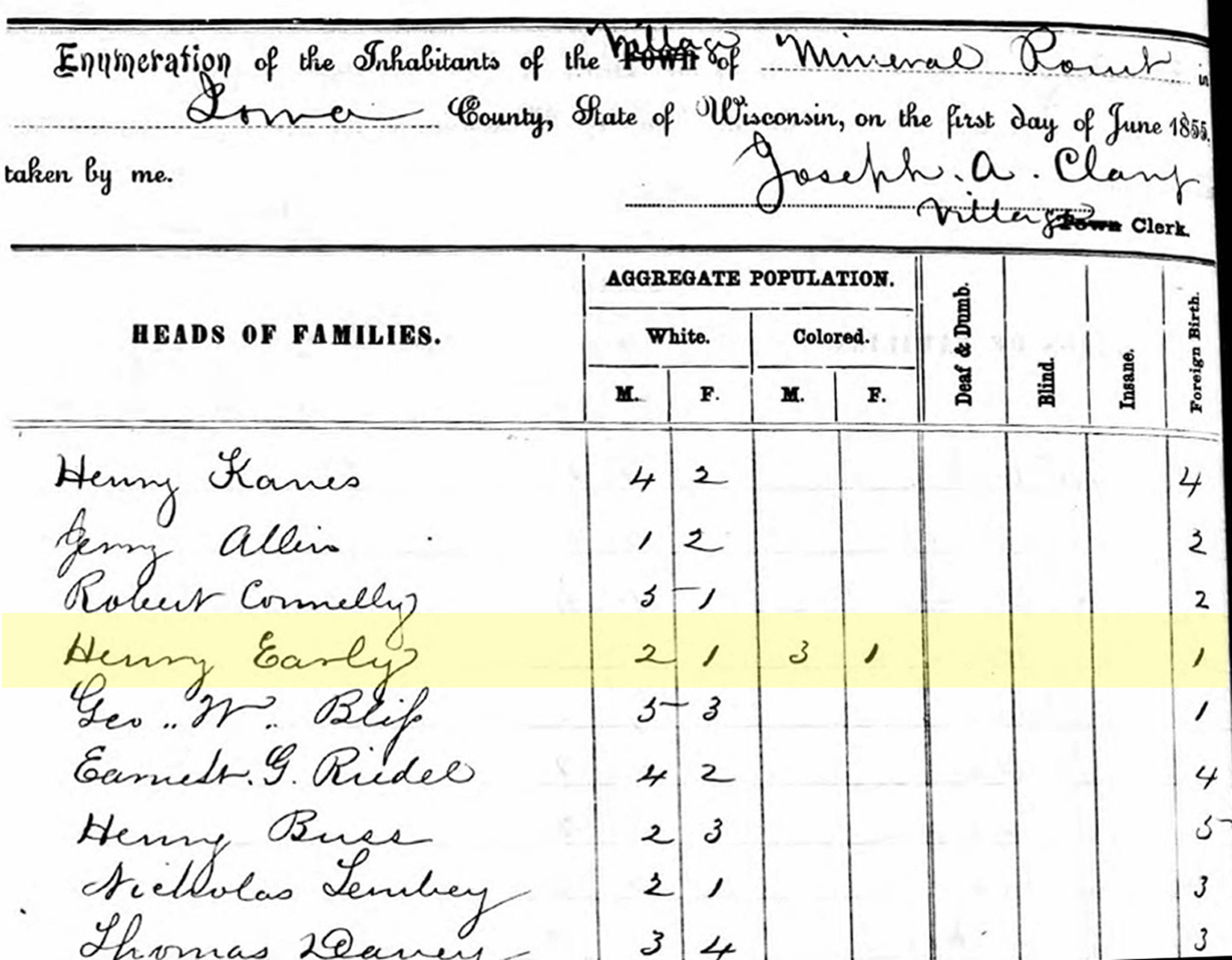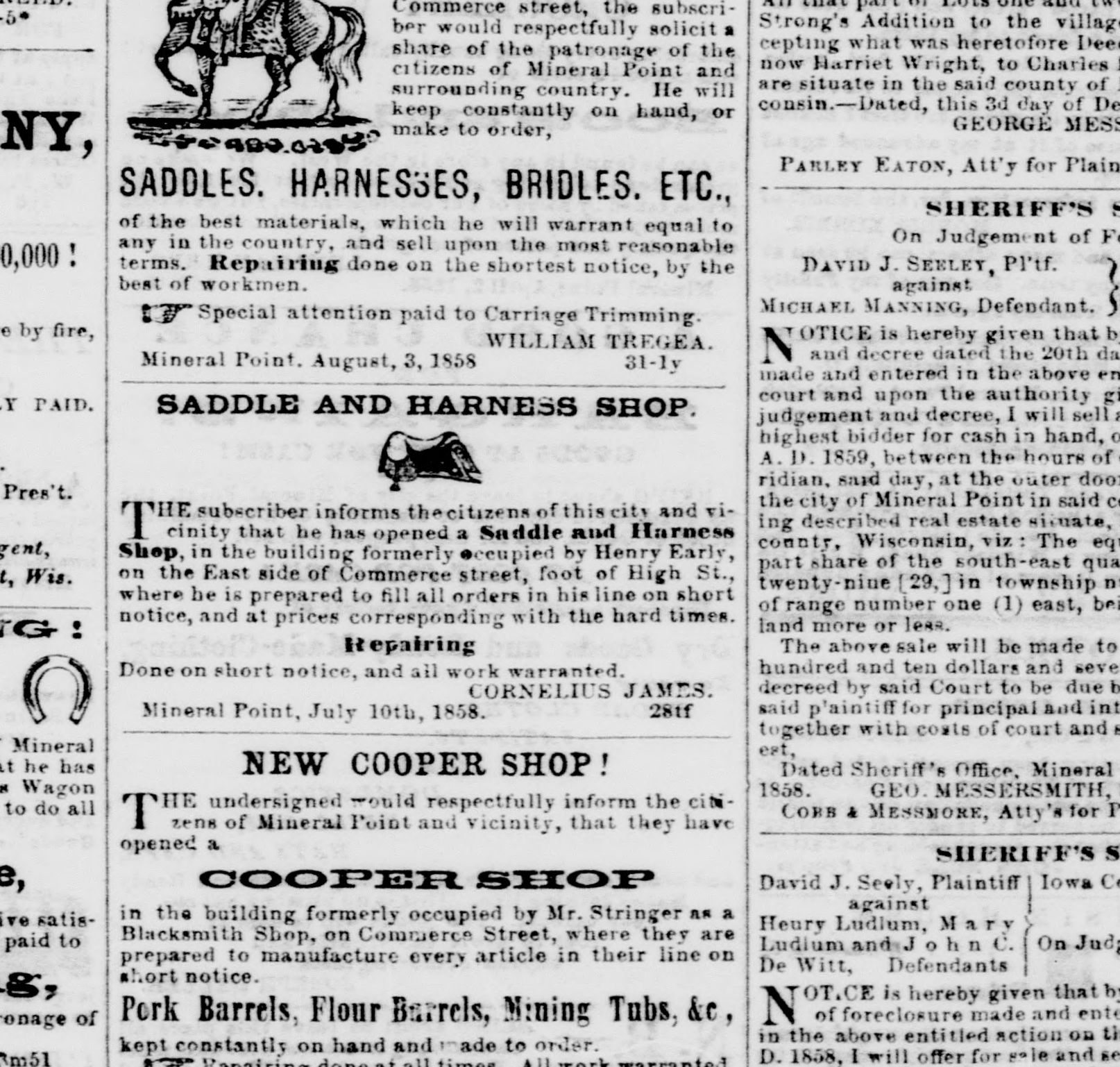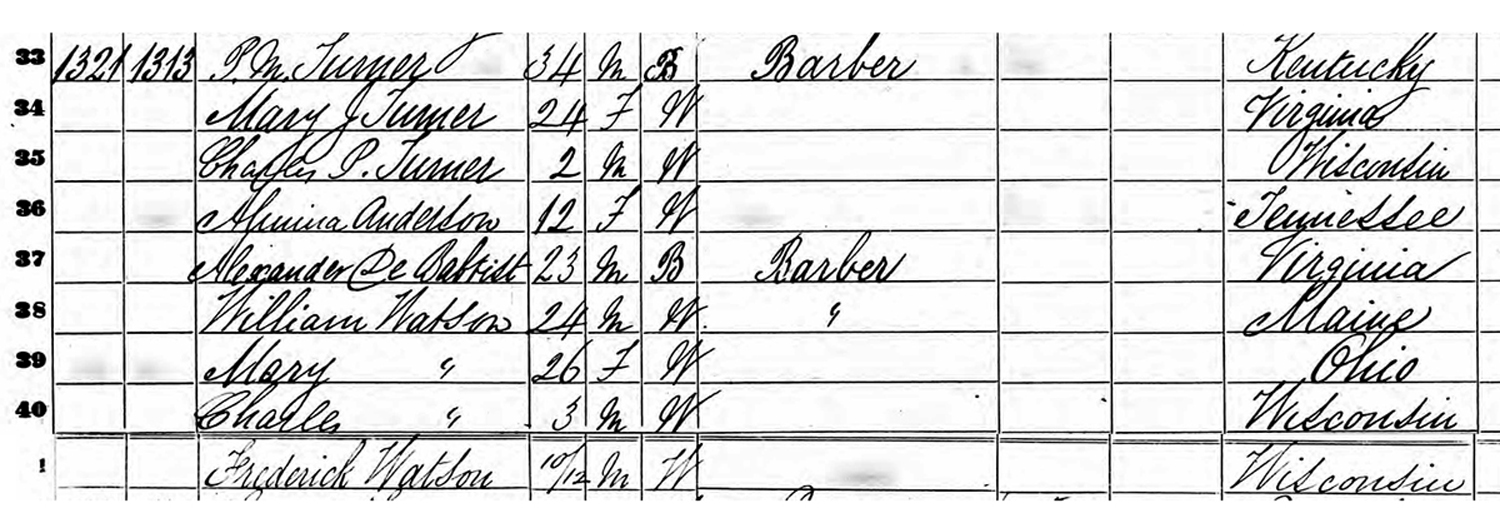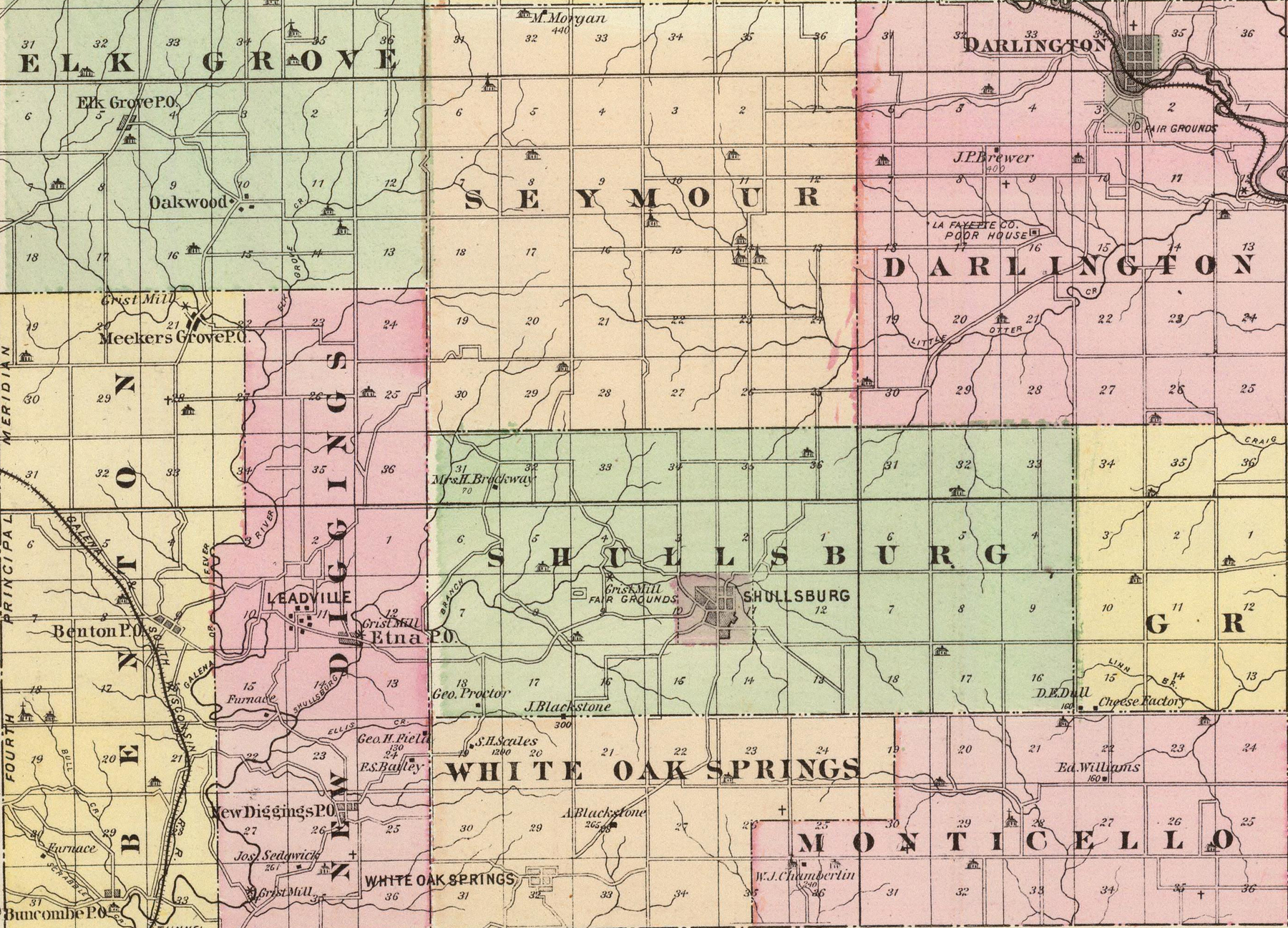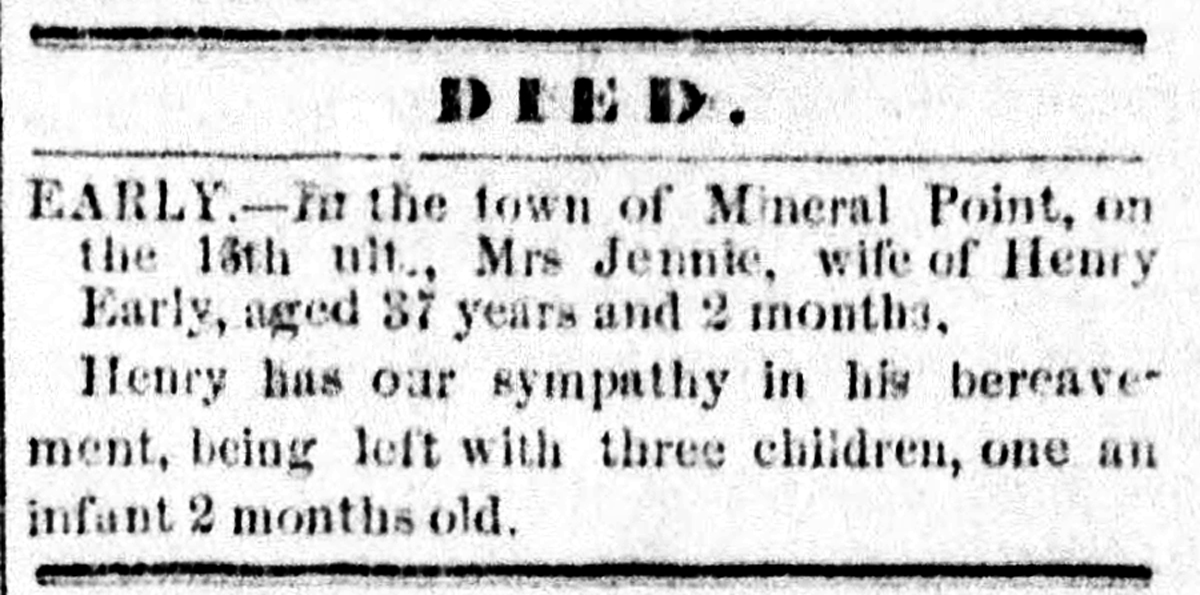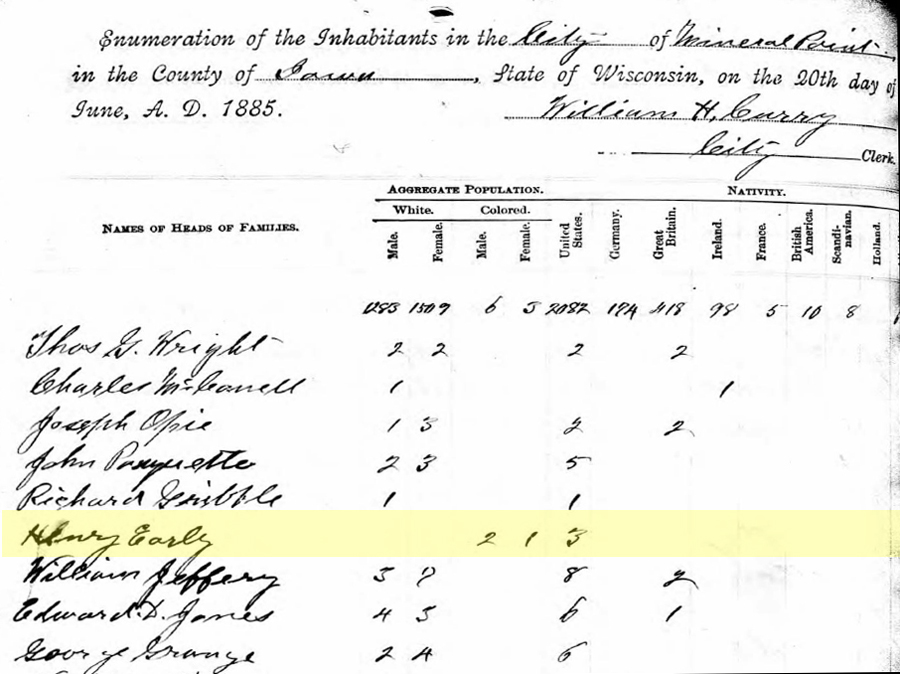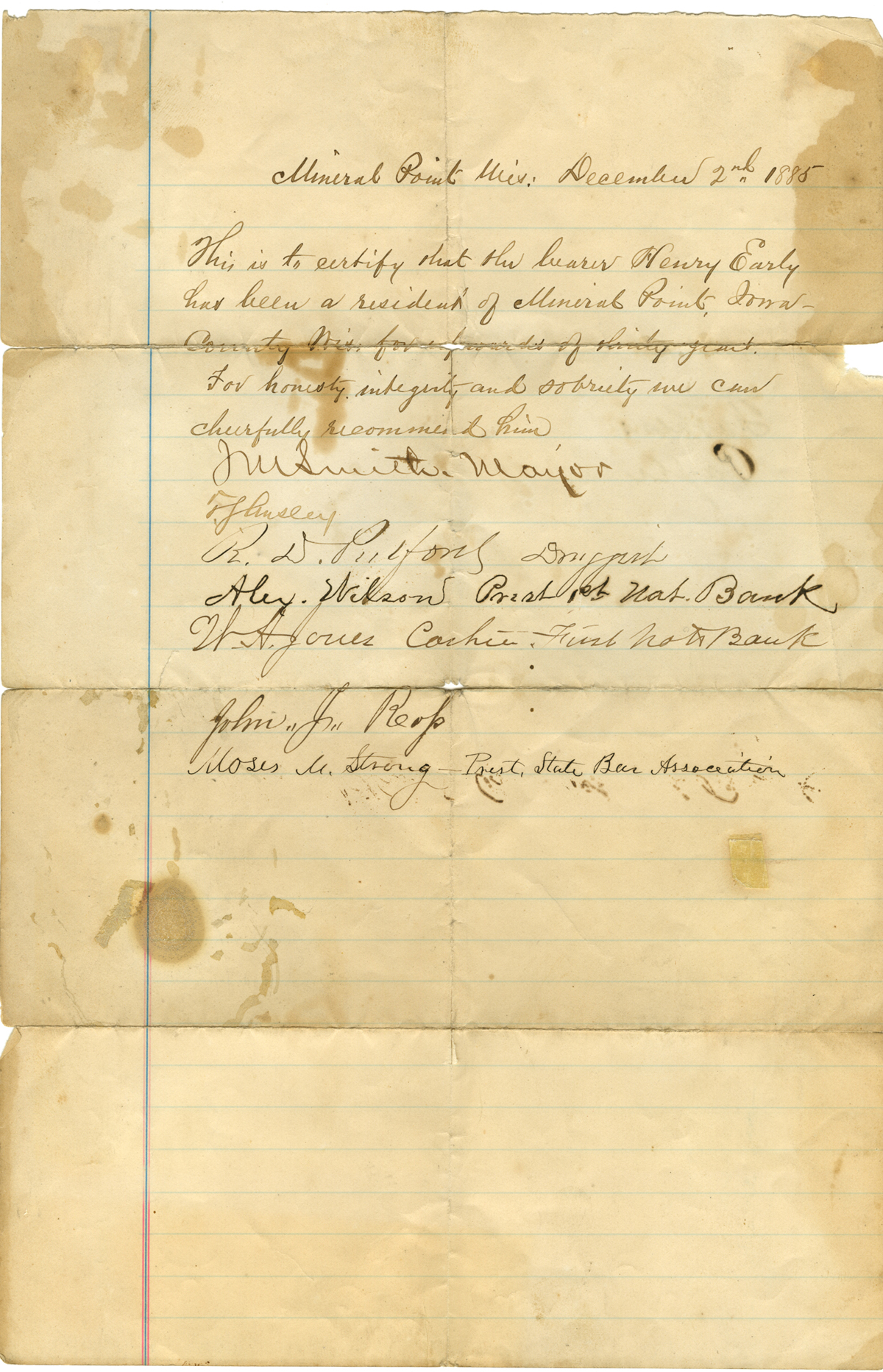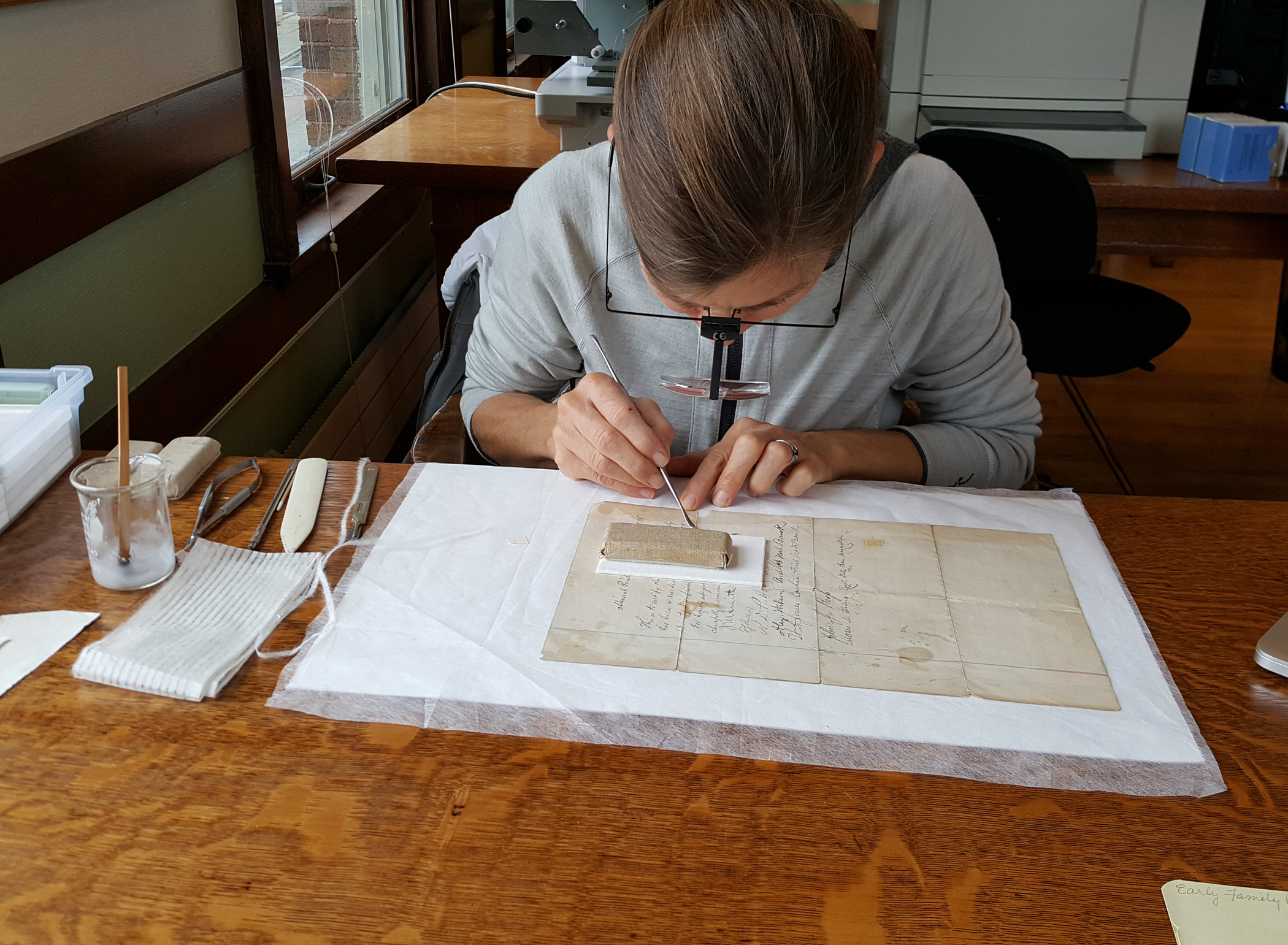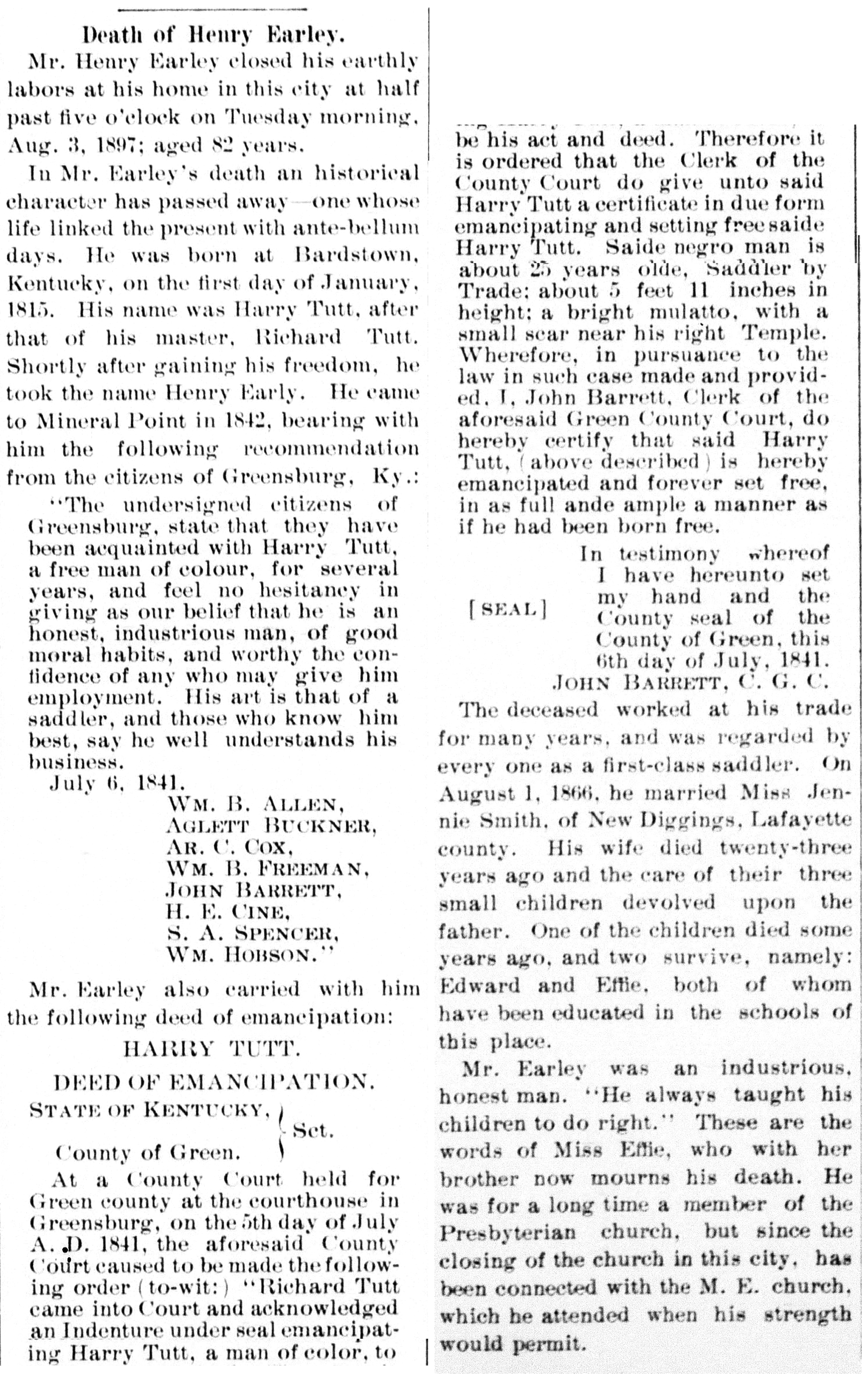Henry Early
From Slavery to Mineral Point Businessman
Born Into Slavery
Henry Early (1815-1897) was born into slavery on January 1, 1815, in Bardstown, Kentucky. His birth name was Harry Tutt.
Bardstown, Kentucky (1816)
Kentucky along the Ohio River, 1816. Bardstown is southeast of Louisville.
Emancipated
On July 5, 1841, at the Green County (KY) courthouse, Harry Tutt, "a man of color," was emancipated by Richard Tutt. The Clerk of the County Court gave him a Deed of Emancipation, "emancipating him and forever setting him free." He was described as being "about 25 years olde, Saddler by trade, about 5 feet 11 inches in height, a bright mulatto, with a small scar near his right temple."
There was a Richard Tutt, born in 1801, who came to Greensburg, Kentucky, at the age of 15 or 16 and learned the saddler's trade, serving an apprenticeship with William Hobson, a well-known saddle maker. This may be the same Richard Tuff who freed Harry Tutt, but there are no existing records to confirm this.
We do not know how Harry gained freedom. It is quite possible that he was one of the very few who were able to earn enough money to "self-purchase." He possessed an important and marketable skill: saddlemaking. Sometimes, enslaved people who were skilled in a particular craft were allowed to work for themselves after completing their assigned tasks and were permitted to keep the income they generated.
It was challenging to work a full and tiring day for the master and then take on additional work, but some strong and determined individuals were able to do so. In 1839, 42% of free blacks in Cincinnati had purchased their own freedom. Harry Tutt may have known some of these people or had heard of them.
The Journey North
Shortly after gaining his freedom, Harry Tutt changed his name to Henry Early and headed for the Lead Region. He arrived in Mineral Point sometime in 1842.
Whether he travelled alone or with companions is not recorded, nor is the route he took. He probably made his way from Greensburg to Louisville; from there, he may have followed the Buffalo Trace (marked in red) across Indiana to Vincennes.
If he were planning to go to the Lead Region via the Mississippi River, he would have continued along the Buffalo Trace, across southern Illinois to St. Louis, Missouri.
The Buffalo Trace was originally formed by migrating buffalo and was used as a roadway for centuries by Native Americans. It stretched from the Falls of the Ohio to the Wabash River and from there to the Mississippi River. It was an essential interior land route, used by the military, by settlers, and as a mail route. It was considered so important to the development of the U.S. interior that it was paved soon after Indiana became a state in 1816; regular stagecoach service began in 1820.
If Henry did travel to St. Louis, he most likely took a steamboat or keel boat up the Mississippi River to Galena, Illinois. He may have saved enough cash to buy a ticket as a passenger, or he may have planned to work as a deckhand in exchange for passage.
He may have changed his plans, though, as St. Louis was in turmoil in the summer of 1841. Four rivermen - three free Black men and one who was still enslaved - were hanged in July in a public spectacle on an island in the Mississippi. They had been convicted of robbery and of murder and arson in connection with the robbery and were executed for the crimes.
For months after, the St. Louis and New Orleans newspapers raised alarms about the freedoms of freed Black rivermen and the dangers of allowing them to work on the river.
If Henry decided to avoid St. Louis, there were several other routes through Illinois. If he went first to Galena before heading north to Mineral Point, he probably took the route that passed through Peoria.
Or, he might have travelled north from Vincennes to Fort Dearborn and Chicago and from there followed a path that went through the Lead Region to Prairie du Chien.
Regardless of the route he chose, he probably covered many of the miles on foot. He may have worked odd jobs on the way, repairing harnesses and other leather goods for food, lodging, or cash.
The journey would have been dangerous for him. Even though Illinois was a free state, slave catchers were still active, kidnapping "runaway slaves" and freemen alike and taking them to bordering slave states to sell.
In addition, Illinois had a Black Law, also known as the Black Code. This was being challenged in the courts by 1841, but versions of it had been in effect for decades and affected the attitude of many white residents with regard to people of color.
One of the provisions of the Black Code stated that freed African Americans could only immigrate to Illinois if they possessed a certificate of freedom or if they posted a $1,000 bond. We can be sure Henry kept his Deed of Emancipation close at hand at all times.
Despite the difficulties and dangers of his travels, Henry successfully reached Mineral Point. According to his obituary, published in the Iowa County Democrat on August 5, 1897, he arrived in the area in 1842.
Business in Mineral Point
Henry probably started working at his trade as soon as he arrived. In the 1840s and 1850s, people relied heavily on horses for transportation. If you wanted to go somewhere, you walked, rode a horse, or rode in a horse-drawn wagon, cart, or carriage. If you needed to take or send something from one place to another, you carried it in your hands or on your back, or you put it in a wagon, cart, or carriage pulled by one or more horses. If you were farming anything larger than a small garden, you had at least one team of horses to pull the machinery.
All of these horses, conveyances, and machines required saddles, bridles, or harnesses. A skilled saddler who made and repaired harnesses and other types of leather goods, in addition to saddles, was a vital part of the community.
Henry had his shop in this building (since replaced) on Commerce Street at the foot of High Street. The brick building with the awning at the right is now the Dean Medical Clinic. The building with the double porch, on the left, was Mark Terrill's City Hotel. The site is now a small parking lot for the clinic.
This receipt from S.P. Smith & Co. in Galena, Illinois, lists things Henry bought for his business on August 9, 1847: one yard of worsted web, one pair of polished stirrups, two pairs of plated stirrups, one snaffle, one side bridle, two sheep skins, a half dozen ship lashes, one splitting gauge and one pair of ivory mart[ingale] rings.
This is one of the pages from Henry's cash book, where he recorded sales and payments he received. This page is the account of Judge M. M. Cotheren. It started in April 1848, when Henry repaired a halter for $0.75.
Henry never advertised in the local papers, but other saddlemakers did. This 1847 advertisement for C. G. Rodolf lists the wide variety of leather goods that a saddler might sell, make, or repair.
The 1850 census says Henry could not read or write. This 1850 receipt shows that he could sign his name, but the signature differs from the penmanship in his meticulously kept cash books. Did he keep his own records, or did he have someone else maintain them on his behalf? If so, who would it have been?
Life in Mineral Point
The 1850 census shows Henry Early living in Mineral Point. It notes his age as 33, his race as "M" for "Mulatto", his birthplace as Kentucky, his occupation as "Sadler", and indicates that he cannot read or write (as indicated by the tick mark in the right-hand column). The "50" and "50" in the left-hand columns indicate that he was living in a separate building within his own household, but we do not know the location of this building. The Dr. David Ross and Edwin Bawden families were near neighbors.
In 1852, Henry paid a fifty-cent city tax to own a dog. This was probably like having a dog license today.
In July and August of 1853, Henry placed an ad in the local newspaper offering a reward for the return of a horse that had been stolen or that had strayed away.
"From the Subscriber living in Mineral Point, on the 17th inst., a light sorrel yearling mare colt. Said colt has a white spot on her forehead about as large as a dollar, and three white legs. Any person who will return said cold, or give information where said colt may be found shall receive the above reward."
On June 6, 1854, Henry bought Lot 26 in Irvin's Addition from Martin van Burris for $400.
The house was on the northwest corner of Liberty and Second streets and appears on the 1872 birdseye map of Mineral Point. The large building north of the house was the Fourth Ward School (no longer standing). The Odd Fellows building is on the corner of Front and State streets.
The lot probably included a small house, although the house is not mentioned until the 1858 tax assessment.
The 1855 census of the Village of Mineral Point shows Henry Early as the head of a household that includes 2 white males, 1 white female, 3 "colored" males, and 1 "colored" female. Members of the household are only identified by tick marks; no names are listed, so we don't know who these other individuals were, their ages, places of origin, or occupations.
By the middle of 1858, Cornelius James was advertising his Saddle and Harness Shop in the building "formerly occupied by Henry Early." Henry's account books do not have any entries after the middle of 1858; apparently, he had moved on by then.
The 1860 census of the Town of Willow Springs in Lafayette County lists Henry living in the household of Hugh Patterson, with his occupation recorded as "farm laborer." It gives his age as 36, which is about ten years younger than his actual age. All of the people in the household are listed as "mulatto."
A near neighbor is D. M. (Daniel Morgan) Parkinson. Parkinson's home was east of Mineral Point on what is now Highway 23, just south of the Lafayette/Iowa County line.
The 1860 census records two Black men living in this house in the City of Mineral Point. Both men are barbers. Others in the household are two white women, a White man (also a barber), and several children.
Are these the same people listed in the 1855 census in Henry Early's household? If so, they are probably living in the house on Liberty St., as Henry did not sell it until 1863.
On August 1, 1866, Henry married Mary Jane (Jennie) Smith in Lafayette County. In 1850, at the age of 13, Mary Jane was a servant in the household of Frederick, William, and Elizabeth Dering in New Diggings. Ten years later, she was a domestic in the household of Ami Dodge in New Diggings.
In 1870, Henry, Mary J., and their one-year-old son, Edward, were in New Diggings in the household of Michael Downes, a married man with a three-year-old daughter.
Henry is a laborer and Mary J. a domestic; Henry has real estate valued at $500 and personal possessions valued at $3,000.
Illustrating the arbitrariness of race, in 1850, the census taker lists Mary Jane as "mulatto"; in 1860, as "black"; and in 1870, all of the Earlys, as well as all of the Downes, are listed as "white."
Mary Jane "Jennie" Early died on February 13, 1874. Her son, Edward, was six years old, her daughter, Effie, was three, and a third child was two months old. She is buried in the graveyard of the Leadmine Primitive Methodist Church in New Diggings. The Early family was living in the Town of Mineral Point at that time.
By 1855, Henry, Edward, and Effie were living in the City of Mineral Point. The infant mentioned in Mary Jane's obituary had died.
In December of 1885, Henry requested a "character letter" from the leading citizens of Mineral Point. Letters like these were commonly carried by free Black citizens in the South and were kept at hand in an attempt to ward off harassment. Apparently, Henry continued this custom when he lived in the North. He no doubt had several similar letters over the years; this is the only one to have survived.
It reads: "This is to certify that the bearer, Henry Early, has been a resident of Mineral Point, Iowa County, Wis., for upwards of thirty years. For honesty, integrity, and sobriety, we can cheerfully recommend him." It is signed by J. M. Smith, Mayor; R. D. Pulford, Druggist; and Alex Wilson, Pres. 1st Nat. Bank; W. A. Jones, Cashier, First Natl Bank; John J Koop [local merchant]; and Moses M. Strong, Prest. State Bar Association.
Kim Nichols, Director of Conservation at the Newberry Library in Chicago, donated her time and expertise to preserve Henry Early's character letter. Along with many other documents referenced here, the letter is part of the Mineral Point Library's archival collection, available to visiting patrons and researchers.
Henry Early died on August 3, 1897. His obituary in the Mineral Point Tribune was lengthy and respectful. He is buried in Graceland Cemetery, Mineral Point.
